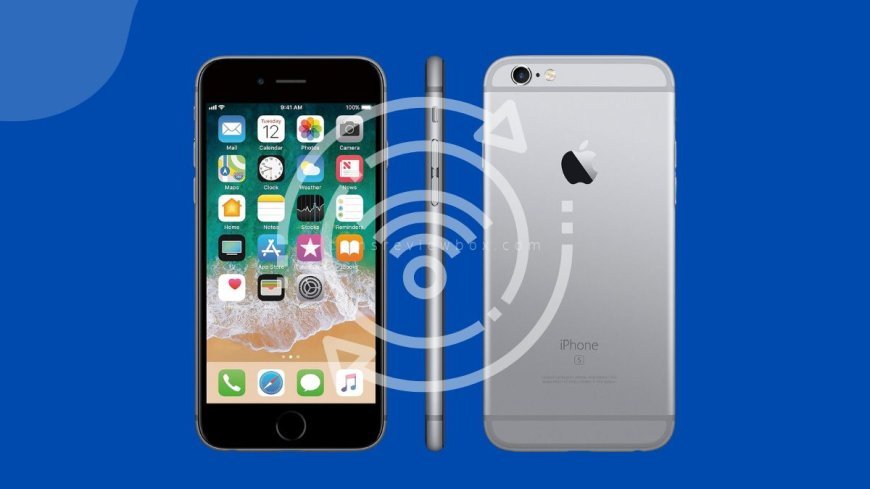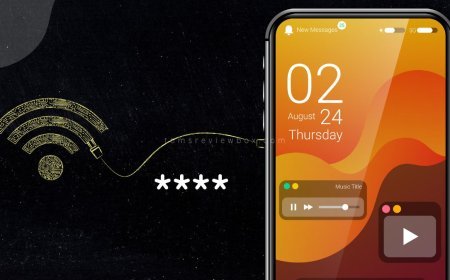How to Reboot iPhone 6 : Complete Guide
Discover the complete guide on how to effectively restart your iPhone 6 and learn the step-by-step process. Turn your device off and back on easily!

Looking to hard reset your iPhone 6 but not sure how? Whether you're a tech novice or just need a quick refresher, we've got you covered. In this guide, we'll walk you through the simple steps to reboot your iPhone 6 effortlessly, using the power button. Say goodbye to pesky glitches and hello to a smoother user experience with these easy-to-follow instructions.
Key Takeaways
- Understand the Importance of Reboot: Rebooting your iPhone 6 can resolve many common issues and improve performance.
- Follow Simple Steps to Restart: Press and hold the Power button and swipe to power off; then press the Power button again to turn it back on.
- Know How to Restart Other iPhone Models: Different iPhone models may require variations in the reboot process, so be aware of the specific steps for your device.
- Troubleshoot Restart Problems: If your iPhone 6 doesn't restart, try charging it or contacting Apple Support for assistance.
- Explore Preventative Measures: Regularly updating software and managing apps can help prevent future reboot issues.
- Refer to FAQ for Additional Help: Check the FAQ section for answers to common questions about rebooting an iPhone 6.
Understanding Reboot
Rebooting a device means restarting it to resolve issues and refresh its system. It involves turning off and then turning on the phone using the wake button.
Understanding why rebooting is essential for electronic devices is crucial. It helps clear temporary data, close unused apps, and fix minor software glitches.
Differentiating between a regular restart and a force restart is important. A regular restart shuts down the device normally, while a force restart forcibly closes all apps and processes.
Steps to Restart iPhone 6
Basic Restart Process
Restarting your iPhone 6, 7, 8, or SE (2nd or 3rd generation) is a simple process. Press and hold the home button along with the Power button until the slider appears. Slide it to power off. Wait for at least 30 seconds before turning the phone back on. This helps in refreshing the system and resolving minor issues.
To correctly power off and turn on your device, ensure that you press and hold both buttons firmly until the slider shows up on the screen. By doing this, you initiate a clean shutdown of your phone's operating system. Waiting for half a minute before restarting allows the device to reset properly.
Understanding why waiting for 30 seconds before turning your device back on is crucial can help prevent potential software glitches. Giving your iPhone this short break allows it to clear any temporary data stored in its memory, promoting a smoother restart process.
Force Restart Method
In cases where your iPhone becomes unresponsive or frozen, knowing how to force restart it is essential. For older models like iPhone SE (1st generation), 5, or earlier versions without a home button, press and hold the Power button together with the Volume Down button until you see the Apple logo. This action forces a reboot when standard methods fail.
When faced with critical situations such as system crashes or unresponsiveness, opting for a force restart can be a lifesaver. Unlike regular restarts, force restarting bypasses normal shutdown procedures to address immediate issues effectively. It serves as a quick solution to get your device back up and running smoothly.
Discovering when and why you should opt for a force restart instead of a regular one can save you from prolonged downtime during emergencies. Force restarting provides a more direct way to tackle severe software malfunctions that may not respond to conventional restart attempts.
Restarting Other iPhone Models
iPhone X and Later
For iPhone X and later models, the restart process is slightly different. To restart, press and quickly release the Volume Up button, then do the same with the Volume Down button. Next, press and hold the Side button until you see the Apple logo.
The key difference in restarting these models lies in the absence of a physical Home button. The specific button combinations for restarting newer iPhones involve using the Volume buttons along with the Side button.
iPhone 7 and 8 Series
To restart your iPhone 7 or 8 series, start by pressing and holding both the Side button and either volume button simultaneously. Release them when you see the Apple logo appear on the screen.
When dealing with these models, it's essential to remember that due to changes in design, they may not respond to traditional methods like older iPhones. If you encounter issues during restart, try connecting your device to a power source or seeking professional assistance.
Older iPhone Models
For older iPhone models without Face ID or edge-to-edge displays, restarting involves pressing and holding down the Power/Sleep/Wake button until you see the slider appear on the screen. Drag the slider to power off your device completely.
Older iPhone models have distinct characteristics in terms of button placement and functionality compared to newer versions. Understanding these differences is crucial for effectively restarting devices such as iPhone 6 and earlier.
Troubleshooting Restart Issues
Common Problems
When your iPhone 6 starts acting up, you may encounter several common issues that necessitate a reboot. Battery drain, slow performance, and unresponsive apps are frequent problems that can often be resolved with a simple restart. By turning off and on your device, you can address these software-related issues effectively. Troubleshooting through a reboot is essential before considering professional assistance.
e other issues that may require a reboot include Wi-Fi connectivity problems, Bluetooth malfunctions, and software freezes. These glitches can disrupt the normal functioning of your device but can usually be fixed by performing a quick restart. Understanding the significance of rebooting in addressing these issues can save you time and effort in seeking technical support.
Solutions
Rebooting your iPhone 6 offers various solutions to common problems that users encounter. A simple restart can help in resolving app crashes, system lag, and screen unresponsiveness. By shutting down and restarting your device, you give it a fresh start to rectify these software-related concerns efficiently.
For instance, if you notice that your iPhone 6 is running slow or certain apps are crashing frequently, a reboot can often provide an immediate fix. This straightforward solution is effective in clearing temporary system glitches and ensuring smooth operation of your device. The power of a reboot lies in its ability to refresh the system and eliminate minor bugs that may cause disruptions.
When You Can't Restart Your iPhone 6
Identifying the Issue
If your iPhone 6 is unresponsive or acting strange, it might be time to consider a reboot. Look for signs like frozen screen, apps crashing frequently, or slow performance. These could indicate a need for a simple restart.
In some cases, a reboot might not work if the issue is more complex. If problems persist after restarting, it's essential to explore further solutions or seek professional help. Issues like hardware malfunctions or software glitches may require expert intervention.
etimes, issues with your iPhone 6 may go beyond what a reboot can fix. If you notice persistent problems like battery draining rapidly or the device not turning on at all, it's best to consult with Apple support or visit an authorized service center.
Professional Help
When basic troubleshooting methods fail to resolve your iPhone 6 issues, it's crucial to consider seeking professional help. Rebooting may not be effective for certain complex problems that require specialized attention.
Understanding the limitations of rebooting is key when facing more serious iPhone 6 issues. Knowing when to escalate problems to experts can prevent further damage and ensure proper diagnosis and repair.
Contacting Apple support or visiting an authorized service center are viable options for advanced iPhone 6 problems. These professionals have the expertise and tools needed to address intricate hardware or software issues effectively.
Preventing Future Issues
Regular Updates
Keeping your iPhone software up to date is crucial for optimal performance. Regular updates can prevent certain issues that may lead to the need for a reboot. By installing the latest iOS versions, you ensure that your device functions smoothly without glitches or errors.
Benefits of regular updates:
- Improved security features
- Bug fixes and performance enhancements
- Compatibility with new apps and services
Why are regular updates important?
- They address vulnerabilities that hackers can exploit.
- Updates optimize system functions, reducing the likelihood of crashes.
Avoiding Common Mistakes
When rebooting your iPhone, it's essential to avoid common mistakes that could harm your device. Identify these errors to ensure a smooth restart process. By understanding potential pitfalls, you can safeguard your phone from unnecessary damage.
Common mistakes users make:
- Holding down the power button too long
- Ignoring low battery warnings before rebooting
Consequences of improper rebooting:
- Data loss due to abrupt shutdowns
- Potential hardware damage from forced restarts
FAQ on iPhone 6 Reboot
Basic Queries
Rebooting an iPhone 6 can solve a variety of issues, such as slow performance or unresponsive apps. To reboot, press and hold the power button until the slider appears, then slide to power off. Wait a few seconds before holding the power button again to turn it back on.
Users often wonder if rebooting their iPhone 6 will delete any data. The answer is no; rebooting simply refreshes the device's operating system without affecting personal files or settings. It's a quick fix for minor software glitches that can occur from daily use.
e users may mistakenly believe that rebooting an iPhone 6 is only necessary when facing major problems. However, regular reboots can help maintain optimal performance by clearing temporary files and refreshing system processes. It's like giving your device a fresh start.
Advanced Troubleshooting
For more complex issues beyond a simple reboot, advanced troubleshooting techniques may be required for your iPhone 6. If your device is frozen or unresponsive after a standard reboot, try performing a hard reset by holding down the power and home buttons simultaneously until you see the Apple logo.
In cases where advanced troubleshooting steps are needed, consider restoring your iPhone 6 through iTunes. This process involves erasing all data and settings on the device and reinstalling the operating system. Make sure to back up your data before proceeding with a restore.
Knowing when to employ advanced troubleshooting methods is crucial for maintaining your iPhone 6's functionality. If basic solutions don't resolve persistent issues like frequent crashes or hardware malfunctions, seeking professional help from Apple Support or authorized service providers is recommended.
Final Remarks
Now that you are equipped with the knowledge of how to reboot your iPhone 6 and troubleshoot any issues that may arise, you can ensure a smoother user experience. Remember the steps outlined for restarting your device and the preventive measures discussed to avoid future complications. By following these guidelines, you can maintain the optimal performance of your iPhone 6.
Don't hesitate to reach out for further assistance if needed. Stay proactive in addressing any reboot concerns promptly to keep your device running efficiently. Your iPhone 6 is a valuable tool, and taking care of it will prolong its lifespan and functionality. Keep these tips in mind to make the most out of your device.
Frequently Asked Questions
How do I reboot my iPhone 6?
To reboot your iPhone 6, press and hold the Power button along with the Home button simultaneously until you see the Apple logo on the screen. Then release both buttons and wait for your device to restart.
Is it safe to reboot my iPhone 6 frequently?
Yes, it is safe to reboot your iPhone 6 occasionally as it can help resolve minor software issues or improve performance by clearing temporary data stored in the device's memory.
Why should I follow specific steps to restart my iPhone 6?
Following specific steps to restart your iPhone 6 ensures that the process is done correctly, reducing the risk of causing any damage to the device or losing important data stored on it.
Can restarting my iPhone 6 fix common issues like freezing or slow performance?
Yes, restarting your iPhone 6 can often resolve common issues like freezing or slow performance by refreshing the device's system and clearing any temporary glitches that may be affecting its operation.
What should I do if I am unable to restart my iPhone 6 using the usual method?
If you are unable to restart your iPhone 6 using the usual method, try connecting it to a power source and then attempting a restart. If this does not work, consider seeking assistance from an authorized service provider for further troubleshooting.
What's Your Reaction?







































![MacBook Pro M5: All the features and specs you need to know [LEAKS REVEALED]](https://tomsreviewbox.com/uploads/images/202502/image_430x256_67bd6d7cd7562.jpg)



























